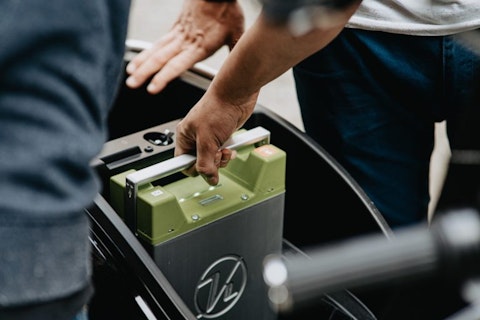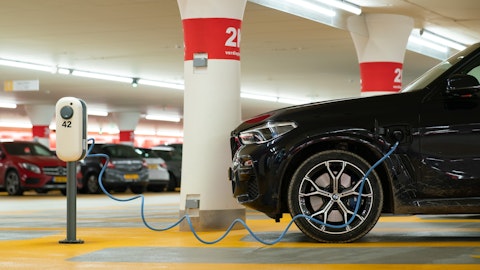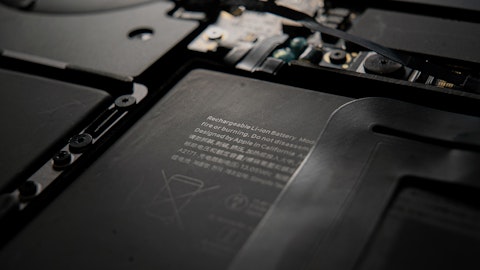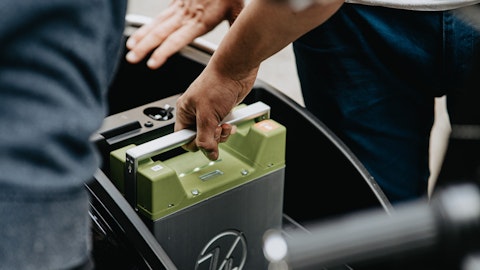QuantumScape Corporation (NYSE:QS) Q2 2023 Earnings Call Transcript July 26, 2023
QuantumScape Corporation misses on earnings expectations. Reported EPS is $-0.22 EPS, expectations were $-0.2.
Operator: Good day and welcome to QuantumScape’s Second Quarter 2023 Earnings Conference Call. John Saager, QuantumScape’s Vice President of Capital Markets and FP&A, you may begin your conference.
John Saager: Thank you, operator. Good afternoon and thank you to everyone for joining QuantumScape’s Second Quarter 2023 Earnings Call. To supplement today’s discussion, please go to our IR website at ir.quantumscape.com to view our shareholder letter. Before we begin, I want to call your attention to the Safe Harbor provision for forward-looking statements that is posted on our website as part of our quarterly update. Forward-looking statements generally relate to future events, future technology progress, or future financial or operating performance. Our expectations and beliefs regarding these matters may not materialize. Actual results and financial periods are subject to risks and uncertainties that could cause actual results to differ materially from those projected.
There are risk factors that may cause actual results to differ materially from the content of our forward-looking statements for the reasons that we cite in our shareholder letter Form 10-K and other SEC filings, including uncertainties posed by the difficulties in predicting future outcomes. Joining us today will be QuantumScape’s Co-Founder, CEO and Chairman, Jagdeep Singh; and our CFO, Kevin Hettrich. Jagdeep will provide a strategic update on the business and then Kevin will cover the financial results and our outlook in more detail. With that, I’d like to turn the call over to Jagdeep.
Jagdeep Singh: Thanks, John. At the beginning of 2023, we set out a few key goals to enable our transition from technology prototype to commercial product. With the first half of the year behind us, we’re pleased to share an update on our progress. The first of our 2023 goals was to increase the cathode loading of our cells, which increases cell energy by packing more cathode active material into the same area. Last quarter, we shared testing results of two-layer unit cells using higher loading cathodes, which our system enables thanks to our anode-free lithium-metal technology. This design eliminates the graphite host material used in conventional battery anodes, reducing the transport distance lithium ions have to traverse as the battery cycles and allowing for higher cathode loadings.
These new cathodes are capable of storing more energy, not only compared with the cathodes in cells we previously shipped to customers, but also relative to the cathodes used in commercial cells such as the 2170 battery, which powers some of today’s best-selling EVs. We’re happy to report that we have now shipped high cathode-loading unit cells to multiple automotive partners in line with our development roadmap. This is an important milestone because this level of cathode loading is close to our commercial intent cathode loading design for energy dense cells and represents a significant step towards delivering a commercial product. In our view, when combined with the 24-layer capability we’ve already shown in our A0 prototype cells and other planned improvements, this shipment represents a validation of our ability to achieve industry-leading energy and power performance for our first commercial product.
On that subject, as we announced last quarter, our first commercial product is planned to be a 5 Ah cell, which we believe will offer a compelling combination of energy density and power unmatched by the leading EV batteries available today. We are designating this first product QSE-5 and are already working closely with a prospective launch customer in the automotive sector for this cell, with the goal of bringing our next-generation technology to the electric vehicle market as rapidly as possible.
,: We believe this is a unique selling point with our technology enabling longer range, higher power and faster charging. We believe automotive OEMs gain the ability to better differentiate their EV offerings. Note that delivering on our product roadmap will undoubtedly require us to successfully address many technical and manufacturing challenges, including our key goals for 2023 and beyond. However, we believe QSE-5 raises the bar for EV performance and puts battery development on a fundamentally new trajectory. Now a word on our technical development. Last quarter, we shared data from high-power discharge of unit cells with high-loading cathodes. This showed that in our system, cathodes optimized for high energy density can also meet the demands of high performance vehicle applications.
Of course, in addition to high-rate discharge, improving the driving experience of electric vehicles also requires high-power fast charging. We’ve targeted the ability to charge from 10% to 80% in approximately 15 minutes for our first commercial product. Faster than conventional energy cells used in today’s best-selling EVs. Fast charge rates present a challenge for conventional cell architectures, which have to transport lithium ions from one side of the battery to the other and then drive them into the graphite or silicon host material, which imposes a kinetic penalty that limits power. Our system unlocks higher performance by plating lithium directly on the anode layer without the need for a host material. The lithium ions in our system have a shorter distance to traverse and don’t incur the diffusion penalty of intercalating into a graphite host material, as is the case in the conventional cell.
As a result, in our system, lithium can plate as fast as the cathode can deliver it. Thanks to this fundamental advantage, we’ve now demonstrated unit cells capable of meeting our 15 minute 10% to 80% fast charge target, even with a high loading cathode. As shown by data published in our shareholder letter. Our anode-free design enables not only higher energy density via higher cathode loading and a thinner anode, but also higher power density as a result of shortened ion transport paths. This fundamental advantage is why we believe our technology is capable of an unmatched combination of energy and power. Another key technical development milestone is safety testing. In Q2, we ran a suite of safety tests on our A0 prototype cells, including nail penetration, overcharge, external short circuit and thermal stability testing up to 300°C.
And we’re pleased to report that the A0 prototype cells successfully passed these safety tests. According to the specification set by a leading automotive prospective customer. We attribute these impressive results to our solid state architecture, which replaces the combustible polymer separator in conventional lithium-ion cells with a noncombustible solid-state ceramic separator and also eliminates the graphite fuel from the anode. However, it’s important to note that safety is a function of cell materials and design, and as we improve packaging efficiency and energy density for QSE-5, the cell itself will have different physical characteristics and potentially a different safety profile. Any new cell design must be retested to establish its behavior under abuse conditions.
We also made significant progress last quarter on our manufacturing scale-up process. We reported previously on an innovative fast separator heat-treatment process that offers the potential for dramatically better throughput. Initial deployment of this fast process is another key goal for 2023, and we plan to roll it out in two stages, which we’ve dubbed Raptor and Cobra. The underlying work on these processes has been ongoing for several years and as the data has come in, it’s clear that fast separator processes are the endgame for our separator production. Raptor introduces a step-change process innovation, which allows continuous-flow heat treatment equipment to process separator films more rapidly while applying less total heat energy per film, increasing the throughput of the equipment and bringing down the cost of producing an individual separator.
Raptor is intended to support production of initial B0 samples from QS-0 in 2024, and so our goal is to qualify Raptor for production by the end of 2023. We’re pleased to report that installation of Raptor equipment is complete and we continue to expect initial production to begin before the end of the year. Cobra is a further evolution of the fast separator process, which builds on the innovation of Raptor and adds even faster processing and better unit economics. We see Cobra as a groundbreaking innovation in ceramics processing and we believe it represents the best pathway to gigafactory-scale manufacturing. We’re currently operating prototypes of Cobra and intend to roll out our first production Cobra system to support higher volume B-sample production from QS-0.
Finally, I’d like to take a moment to look at the bigger picture and our strategic outlook. At the start of the year, we set our focus on moving from our first 24-layer A0 prototypes, which we shipped at the end of 2022, to a first commercial product design with initial lower-volume B0 sample production currently slated for next year. To achieve this transition from prototype to product, we set four key goals. Introduce high-loading cathodes, bring up our fast separator production process, optimize packaging efficiency and improve cell quality, consistency and reliability. Midway through 2023, we’re excited and encouraged by our progress against these goals. We’ve demonstrated 800 cycles with high-loading cathodes in unit cells and have begun sampling high-loading unit cells to prospective automotive OEM customers for validation in their own labs.
With Raptor equipment now fully installed and beginning qualification, we’re making good progress on implementing our faster separator production process. On packaging efficiency, our QSE-5 product is being developed for a slimmer version of our A0 packaging, which we believe will allow for an unmatched combination of energy density and power performance better than 800 watt-hours per liter, with the ability to charge from 10% to 80% in approximately 15 minutes. As our product roadmap shows, we also believe our solid-state lithium-metal technology unlocks significant design headroom and can put EV battery development on a fundamentally new trajectory. As a result of our ongoing quality improvement initiatives, we’ve integrated in-line improvements to our manufacturing processes and metrology systems, which are showing encouraging improvements to reliability.

Photo by Kumpan Electric on Unsplash
Ongoing improvements throughout the year have allowed us to ship high cathode-loading unit cells to customers in line with our development schedule. Hopefully it’s clear from these results that our team of more than 800 engineers, technicians and business personnel has been laser-focused on doing what it takes to bring our first commercial product to market. As we always emphasize, there is much work still to be done on our path from prototype to product and unforeseen challenges will almost certainly arise. However, at the close of Q2, we’re excited by the momentum we’ve built and energized to tackle the remaining challenges on the path to commercialization. We look forward to sharing more as we continue ahead. With that, I’ll hand it over to Kevin for a word on our financial outlook.
Kevin?
Kevin Hettrich: Thanks, Jagdeep. The second quarter 2023 capital expenditures were $25 million. GAAP operating expenses were $124 million. Cash operating expenses, defined as operating expenses less stock-based compensation and depreciation were $64 million. For the full year 2023, we maintain our guidance on capital expenditures of $100 million to $150 million and cash operating expenses of $225 million to $275 million. During Q2, our CapEx primarily went toward facility spend for our consolidated QS-0 pre-production line. Other notable CapEx spend was driven from progress payments made toward various equipment projects, including equipment for the Raptor process. For the remainder of the year, our CapEx will continue to be allocated toward facility work and equipment for our consolidated QS-0 pre-production line.
We ended Q2 with over $900 million in liquidity. We continue to look for opportunities to optimize our spending and be prudent with our strong balance sheet. We maintain our guidance that our cash runway is forecast to extend into the second half of 2025. Any funds raised from capital markets activity, including under our ATM prospectus supplement, would further extend this cash runway. Longer term, our capital requirements will be a function of our industrialization business model, which we believe could reflect a mix of wholly owned production, joint venture and licensing relationships.
Operator:
A – John Saager: Thanks, Kevin. We’ll begin today’s Q&A portion with a few questions we’ve received from investors or that I believe investors would be interested in. Jagdeep, our first question is for you. Can you expand a bit more on the launch customer that you mentioned in the shareholder letter?
Jagdeep Singh: So we can’t say much more than we said in the shareholder letter, which is that we’re already working closely with the prospective launch customer in the automotive sector for a QSE-5 cell. The two points I would take away are one is with the QSE-5 cell. We’ve defined a specific set of functionality that we believe offers a compelling combination of energy and power that we can deliver in the near term. And two, customer interest that we’ve seen in the cell provides further evidence that the market is excited about this unique capability and that the value proposition is compelling. We look forward to sharing more when we can.
John Saager: Okay, thanks. Can you compare the QSE-5 product at launch relative to your expectations of where silicon dominant anode cells may be at the time, notably on energy density and charge times?
Jagdeep Singh: Sure. Let me start by pointing out that when it comes to anodes, a lithium-metal approach offers the highest theoretical gravimetric energy density. And within the category of lithium-metal anodes, an anode-free design offers higher energy density than approaches that require lithium foil. As shown in the Energy power frontier chart in our shareholder letter. For any given chemistry, batteries can generally be optimized either for power or for energy, but not both simultaneously. Doing this requires moving the energy power frontier up into the right, which typically requires a new chemistry. Now, silicon anodes do have the potential to move the energy power frontier incrementally. However, our understanding of silicon anodes today still generally consists of relatively low amounts of silicon, which in our view, limit their value as such, anodes are mostly carbon.
Future so-called silicon dominant anodes have their own challenges. For example, around low-cost production, if they use chemical vapor deposition or with cycle life and 3D extension, which tend to be worse with higher silicon content. What we believe is unique about our technology is the ability to offer a compelling combination of energy density and fast charge, simultaneously representing a step change in performance. Furthermore, with future enhancements such as larger format cells which improve packaging efficiency, we expect energy densities to improve from here. So we believe our technology represents a platform that we can build on over time. We expect our initial product QSE-5 to deliver a better power energy combination than what we believe the industry will be capable of delivering in the near term.
But over time we expect to expand on that lead as we believe we’re just at the beginning of the S curve of our technology. But probably the more important point to close on is that we believe the market is big enough for multiple entrants. If the planned EV transition targets announced by various automakers and governments are realized, we believe there will be more demand for batteries than any new entrant can satisfy.
John Saager: Okay, thanks. Our next question comes from our investor inbox. What are the major challenges you still face in scaling up production?
Jagdeep Singh: So in terms of the main challenges, the first step is to lock and load on the critical aspects of the product definition. We believe we’ve now done that with QSE-5. Once we have the product defined, we need to freeze the major steps of the production process, i.e. how it will be manufactured. Once we do that, we can specify and order manufacturing equipment and tools. And finally, once that equipment arrives, we can install, qualify, turn it up and begin production of QSE-5. This is what we’re doing between now and when we have higher volume B-samples at the end of 2025.
John Saager: Thanks, Jagdeep. Kevin, turning to you now. Investors have been asking about the long-term business model. And in the shareholder letter you mentioned your openness to wholly owned facilities, joint ventures and licensing relationships. Could you walk investors through the advantages and disadvantages and also comment on whether or not QuantumScape needs a wholly owned facility up and running to prove out manufacturability before a partner can build and license the technology?
Kevin Hettrich: Hi, John. Thanks for the question. First, regarding our openness to various business models, our prospective customers have communicated different preferences, ranging from a desire to purchase cells or participate in a joint venture to licensing our technology. And in the fullness of time, we anticipate a combination of wholly owned joint venture and licensing business models would enable us to address the breadth of customer opportunities we see. An advantage to the wholly owned business model is control. QuantumScape receives 100% of the revenue and proceeds generated by the factory, a joint venture adds in the strengths of the partner, for example, customer commitment, manufacturing capabilities and reduces capital requirements for QuantumScape.
And finally, licensing is the most capital efficient model and allows penetration of the market beyond the scale up bandwidth of the QuantumScape manufacturing team. Under a licensing model, we’d look for economics that reflect our product differentiation and look to see both contractual IP protections and alignment of incentives with our partner. As to the final part of your question. Our free pilot production line QS-0 is a wholly owned facility. A core purpose of QS-0 is to serve as a blueprint for subsequent factory scale up irrespective of the business model.
John Saager: Okay. Thanks so much, Kevin. We’re now ready to begin the live portion of today’s call. Operator, please open up the line for questions.
See also 25 Countries with the Highest Rates of Unemployment and 20 Countries with Highest Rates of Infant Mortality.
Q&A Session
Follow Quantumscape Corp
Follow Quantumscape Corp
Operator: [Operator Instructions] We’ll take our first question from Winnie Dong with Deutsche Bank.
Winnie Dong: Hi. Thank you so much for taking my questions. First question is, you mentioned that you’re already working with a prospective launch customer. Can you maybe elaborate on the process and the calculus behind it? How is this different from or the same from the A0 shipments that you’re sending to multiple customers? What more are you working with this particular launch customer on that you’re not necessarily doing with the rest of the other ones yet?
Jagdeep Singh: Yeah. Thanks for the question, Winnie. This is Jagdeep. I’ll go ahead and take that. So the A0 prototypes were just that. They were prototypes that were meant to demonstrate that the core functionality is feasible. What we’re talking about now, of course, is the QSE-5cell, which we believe will be the actual cell that we deliver as our first product. So what we’re doing with this prospective launch customer is working closely to integrate that cell into their design. So we can’t say much more about this, as I mentioned, in the answer to Jon’s question, but I think our takeaway is that we now have a product definition, which is QSE-5. That’s a very specific cell. It’s a 5 amp hour cell that we’ve spoken about before.
And based on the customer interest that we’re seeing, we think the combination of energy and power density of this cell provides is in fact something that the customer base is excited about. So those are the key points that I would emphasize about that product.
Winnie Dong: Okay. Thank you so much. And then the second question is, you know, it seems like you’re making good progress on the equipment installation front. Would you perhaps be able to attach some numbers to either the Raptor and Cobra process? For instance, in the past you’ve provided, you know, X thousand of separate production per week. You know, what would that look like for Raptor and what would that look like for Cobra? Thanks.
Jagdeep Singh: Yeah, absolutely. So you’re right to focus on Raptor and Cobra because that really is what we think. We think the future lies for, for high scale production of our separators. As we’ve said before, the steady state production of our current capability is on the order of 5000 films per week. Film is just another word for separator, and we’ve indicated that we believe the Raptor line is capable of roughly three times that capacity. Now it won’t be there day one. And there are also other bottlenecks that have to get resolved besides the tool itself. So things like the automation to load and unload the tool and so on. But at a fundamental level, the ability of that tool to process films is, is a lot faster than our current process.
And then of course with Cobra, it’s a further improvement in terms of both throughput as well as unit economics on the separator. And there too, we’re really excited about the progress because as we mentioned in our letter, we have four prototype COBRA tools running at this point as well. So we feel good about both those processes. And in fact, I’ll just say in closing, if you look at the cover of our shareholder letter, that’s actually a photo of the Raptor equipment. In fact, that’s specifically those are the load and unload robots that are used to load and unload the Raptor process.
Operator: We’ll take our next question from Chris Snyder with UBS.
Chris Snyder: Thank you. I wanted to ask on the timeline between A sample, B sample, and C sample. In the past, the company has kind of talked about 18 month gaps between each. I believe the shareholder letter from today said a B-sample next year. So I guess my question is, does the prioritization of the QSE-5 cell rather than the larger format, does that change the timeline? Just that, hey, this product seems a lot more commercially ready? Thank you.



